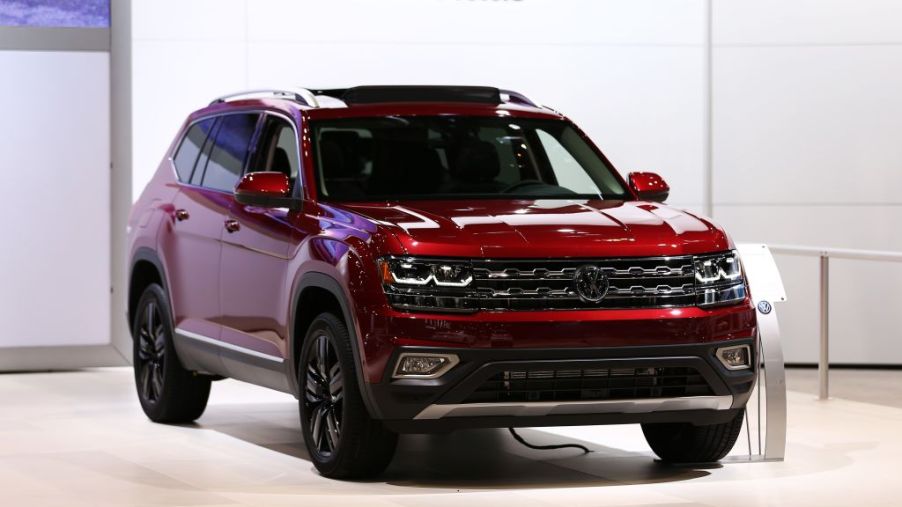
What Did Volkswagen Get Right and Wrong on Its First Two-Row Midsize SUV?
German automaker Volkswagen is known for being a versatile brand, producing fun, zippy, sporty, and efficient vehicles that stand the test of time. But while VW has mastered certain vehicle segments, it’s failed to fill some spots in the market that consumers are after most. In an effort to keep up with the needs of consumers, VW just released its first-ever, two-row midsize crossover. So what did Volkswagen get right and wrong with the Atlas Cross Sport?
Volkswagen’s move into the two-row midsize SUV segment
VW has the compact Tiguan and larger, three-row Atlas, but its hole in the lineup where a two-row midsize crossover should be has been “so wide that you could drive one through it,” according to The Car Connection. And with the demand from consumers for an efficient crossover continuing to grow, VW needed something to go “in the middle.” Its answer to this is the brand-new, two-row 2020 Atlas Cross Sport.
Based on the same platform as its bigger brother, the three-row Atlas, the 2020 Atlas Cross Sport is the first two-row midsize SUV from VW. The Atlas Cross Sport offers a larger cargo area in lieu of the Atlas’ third-row, with smaller dimensions all around. So how did VW do?
What the Volkswagen Atlas Cross Sport does right
According to Kelley Blue Book, the best features of the 2020 Atlas Cross Sport include its massive cargo area, spacious second row, wide range of trim levels and options, and its sleek, sporty styling.
The overall design is sportier than most other SUVs in the segment and according to Car and Driver, takes “a more aggressive, Audi Q8-like angle.” Cutting off the third-row means the roofline drops off sooner, for a much sportier appearance than the Atlas.
Getting rid of the Atlas’ third-row also gives the Atlas Cross Sport a more spacious second-row, with plenty of legroom and split-folding bench seating that offers “up an additional three inches of legroom.” Cargo space in the rear is also impressive.
Base model Atlas Cross Sports come with a turbocharged 2.0-liter four-cylinder engine that makes 235 hp and 258 lb-ft of torque that’s punchier than most competitors. A 3.6-liter six-cylinder making 276 hp and 266 lb-ft of torque is also available.
VW is going all-in with the 2020 Atlas Cross Sport. According to Motor1, it comes available in eight different trim levels: the S, SE, SE w/ Tech, SE w/ Tech R-Line, SEL, SEL R-Line, SEL Premium, and SEL Premium R-Line. With a base price of just over $31,000, the Atlas Cross Sport is an affordable competitor.
Where the Volkswagen Atlas Cross Sport needs work
Though the 2020 Atlas Cross Sport comes with a super-competitive base price, it’s possible to spend a pretty penny getting what you want. According to the same KBB experts, its starting price is right in line with competitors, but “as you approach the higher trim levels, pricing isn’t as close.” For an Atlas Cross Sport with all the fixings, you will have to spend well over $50,000.
The experts mostly agree that the 2020 Volkswagen Atlas Cross Sport could use some work in the driving dynamics department. For a sporty crossover, the Atlas Cross Sport performs more like its bigger and clunkier brother, the Atlas.
While the ride is comfortable, experts found the transmission to be lagging at low speeds and the suspension to be sub-par over bumps in the road. According to Car and Driver, it may be an “SUV that average drivers will find perfectly agreeable,” but it lacks the “sporty driving dynamics” you would expect.
In addition, the Atlas Cross Sport shares so much of its bigger brother’s styling, many are wondering if the new midsize crossover will be able to stand out from the crowd. Though the Atlas Cross Sport comes with much sportier styling, there are plenty of other competitors in the midsize segment designed for a more “rugged” experience.
So similar to the Atlas and not an off-roader, the Atlas Cross Sport may end up directly where it was designed to be: right in the middle.


